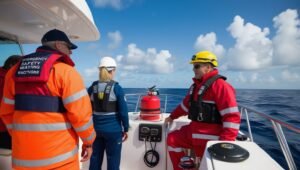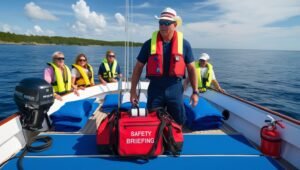
A pre-departure check on a pleasure boat is an important step to ensure the safety of all passengers and the boat itself. The responsibility for carrying out this check usually falls on the captain or operator of the boat, but it also involves the active participation of the entire crew or all passengers on board. This comprehensive article explores who is responsible for the pre-departure inspection of a recreational boat, why it is important, and the specific tasks that should be performed during this check.

Understanding the role of the Captain/Operator
The captain or operator of a recreational boat is legally and morally responsible for the safety of everyone on board. This responsibility includes ensuring that the boat is seaworthy and properly prepared for the voyage. The captain must be knowledgeable about the ship, the expected weather conditions, the route, and any potential hazards. Pre-departure screening is a fundamental part of this responsibility.
Legal Obligations
In many jurisdictions, maritime laws require a boat operator to undergo a pre-departure safety check. Failure to perform this check may result in legal penalties, especially if an accident occurs that could have been prevented with proper preparation. Legal responsibility underscores the importance of the captain’s role in maintaining safety standards.
Moral Responsibility
Beyond legal obligations, the captain has a moral duty to ensure the well-being of everyone on board. This includes taking all necessary precautions to prevent accidents and ensuring that all safety devices are functional and accessible. Pre-departure screening is an expression of this responsibility, demonstrating a commitment to passenger and ship safety.
Role of crew and passengers
While the primary responsibility lies with the captain, crew, and passengers, they also play an important role in pre-departure checks. On larger boats, the crew may be assigned specific tasks, such as checking life jackets, inspecting fire extinguishers, or making sure navigation equipment is working properly. On smaller boats, where official staff may not be present, passengers may assist the captain with various checks.
Active participation
Passengers, especially those with sailing experience, should be encouraged to participate in pre-departure checks. They can help with tasks such as securing loose items, checking that all personal belongings are safely secured, and confirming that the safety briefing has been understood.
Delegation of Tasks
The captain may delegate specific tasks to crew members or passengers, ensuring that no aspect of the pre-departure check is overlooked. This mutual support not only eases the burden on the captain but also fosters a sense of shared responsibility among everyone on board.

Key Components of Pre-Departure Check
A thorough pre-departure check includes several important components, each of which contributes to the overall safety of the trip. These checks are designed to ensure that the boat is fully equipped, that all safety protocols are in place, and that the boat is ready to handle any emergency.
Safety equipment
Life jackets Make sure there are enough life jackets for everyone on board and that they are in good condition. Each life jacket must be easily accessible and properly fitted to each passenger.
Fire Extinguishers Check that all fire extinguishers are fully charged, properly stored, and easily accessible. Make sure everyone on board knows where they are located and how to use them.
First Aid Kit Inspect the first aid kit to make sure it is fully stocked and all items are within their expiration dates. The kit should include bandages, antiseptics, pain relievers, and any necessary prescription medications.
Sound-producing devices Verify that sound-producing devices, such as horns or whistles, are functional and accessible. These devices are essential for signaling to other ships and for emergency communication.
Visual distress signals Check that all visual distress signals, such as flares, are in good condition and not worn out. Make sure they are stored in a place where they can be accessed quickly.
Boat condition
Hull Inspection: Thoroughly inspect the boat’s hull for any damage or signs of wear. Cracks, holes, or other problems must be fixed before departure.
Engine Check Make sure the engine is in good working order, all fluids are topped off and there are no signs of leaks. Test the engine to confirm that it starts and runs smoothly.
Fuel supply: Confirm that there is sufficient fuel for the trip, including a reserve in case of unexpected delays or detours. Check that the fuel tank is secure and there are no leaks.
Electrical System: Inspect the boat’s electrical system, including the battery, lights, and navigation equipment. Make sure all power

Emergency Preparedness
An important aspect of pre-departure screening is preparing for potential emergencies. This includes not only making sure all safety equipment is working but also holding drills and briefings to ensure everyone on board knows what to do in the event of an emergency. have to do
Safety Briefing
Before departure, the captain should conduct a safety briefing for all passengers. This briefing should cover the location and use of life jackets, fire extinguishers, and other safety equipment. Passengers should also be informed of emergency procedures, such as what to do in the event of a man overboard, fire, or collision.
Contingency Exercises.
For long journeys or journeys in difficult conditions, emergency drills may be advised. These exercises may include practicing the use of life jackets, simulating a man overboard situation, or practicing using a radio to call for help.
Weather Testing
Before setting out the captain should check the weather forecast for the entire duration of the voyage. Understanding the expected weather conditions allows the captain to plan accordingly and make any necessary adjustments to the route or departure time. If the weather is expected to be severe, it may be prudent to delay travel until conditions improve.
Final checks before departure
After inspecting all critical components, the captain should perform a final walk-through of the boat. This final check ensures that nothing has been overlooked and that the boat is indeed ready for departure.
Securing loose items
All loose items on the boat should be secured to prevent them from becoming a hazard in rough seas. This includes personal belongings, tools, and any equipment that can move around and cause injury or damage.
Fuel and oil level
Double-check the fuel and oil levels to make sure they are adequate for the trip. It’s also wise to keep extra fuel on hand, especially for longer trips.
Number of passengers
Confirm that the number of passengers on board does not exceed the capacity of the boat. Overloading a boat can make it unstable and increase the risk of capsizing.
Communication along the coast
Before leaving the dock, the captain must inform someone on shore of the intended route and expected return time. This ensures that help can be sent if the boat does not return as planned.

Conclusion
The pre-departure inspection of a pleasure boat is an important task that ensures the safety of everyone on board and the boat itself. Although the primary responsibility rests with the captain or operator, the entire crew and passengers play an important role in the process. By working together to complete a thorough pre-departure inspection, everyone on board can enjoy a safer and more enjoyable boating experience.
Making sure all safety equipment is working, the boat is in good condition, and everyone is prepared for a potential emergency is the foundation of a successful pre-departure check. Whether you’re going on a short day trip or a long one, taking the time to perform this check thoroughly can make all the difference in avoiding accidents and ensuring a safe return.
